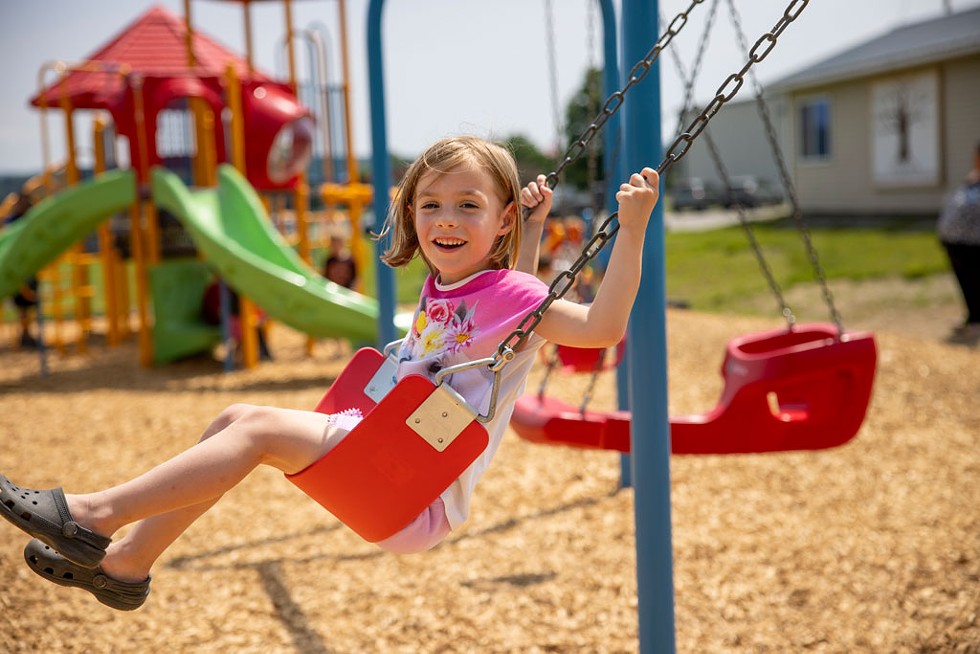
- James Buck
- A kid enjoying the swing set at the new Enosburgh Community Playground
The opening of the Enosburgh Community Playground was a big event for local families. Children who had anticipated the moment for months helped remove the caution tape around the new play structure and quickly made it their own.
On a warm morning in June, a month after the opening, groups of kids pushed each other on the swings, soaked up the summer sunshine and chased each other around. "I’ve not seen a day where there aren’t kids here,” said Margo Longway, director of recreation for the town and mother of four young children. “It brings a lot more community to the area and gives us a space to say, 'Let's go hang out together.'”
As the kids played, a group of parents watched nearby, chatting about the end of the school year. Sage Machia was one of them. She and her husband moved to Enosburgh last year with their three kids, ages 6, 5 and 2. “We used to drive to Richford to go play on a day like this,” she said. Now, she can see her land from the playground. “We can go all the time, and we know the kids that come play here.”
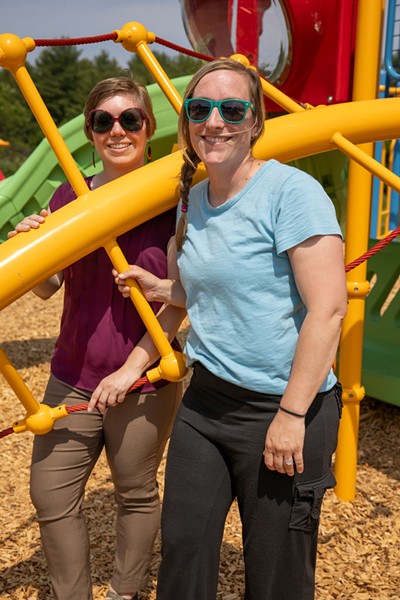
- James Buck
- Enosburg village trustee Heather Moore and playground committee chair Margo Longway
Enosburgh’s new playground isn’t just helping kids get exercise — with each pump on the swings it’s creating the opportunity for social connections that can help knit the community together. Maybe a simple introduction on the playground leads to a long friendship, or maybe it means two longtime neighbors finally know one another's name. So they can wave, say hello and make small talk in a world that is a little less anonymous.
That was very much intentional. The playground is one of 52 community-led projects completed by a program called Better Places; others include the Roxbury Village Park, the Cornwall Outdoor Recreation Area, the High Street Mural in Brattleboro and the Mad River Valley Dog Park in Warren. Since 2020, Better Places has had a 100 percent success rate in helping Vermont communities create welcoming public spaces by providing fundraising coaching and matching grants from the Vermont Department of Housing and Community Development.
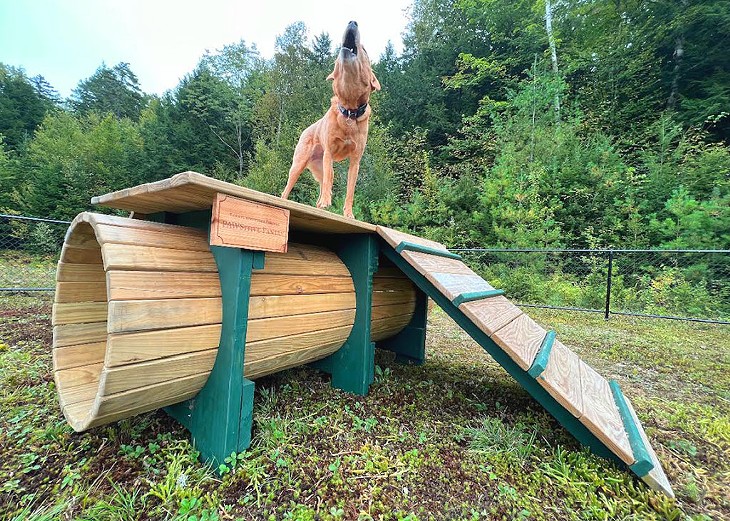
- Courtesy of Eve Silverman
- Piper enjoying the Mad River Valley Dog Park in Warren
Longway headed the volunteer committee that formed to create the Enosburgh playground. Its members scoped out the project and realized they needed $30,000 — a big ask in a rural Franklin County town in which 59 percent of kids in pre-K through fifth grade are growing up at or below the poverty level.
In September 2023, the committee launched a public crowdfunding campaign seeking $10,000. Better Places would come through with a 2:1 matching grant of $20,000 if it reached its goal. To raise the money, members did a coin drop in town and wrote letters to local businesses. By October 31, they’d raised $40,000 – four times what they asked of the community. Because of this, they were able to expand their initial playground design.
Better Places itself is a groundbreaking community matching grant program with support and funding from the state’s Agency of Commerce and Community Development crowdfunding partner Patronicity and the Vermont Community Foundation — a public charity that’s home to hundreds of funds and individual giving accounts created by Vermonters to serve charitable goals. Together the community foundation’s family of funds gives away more than $60 million a year in Vermont, including to programs such as Better Places.
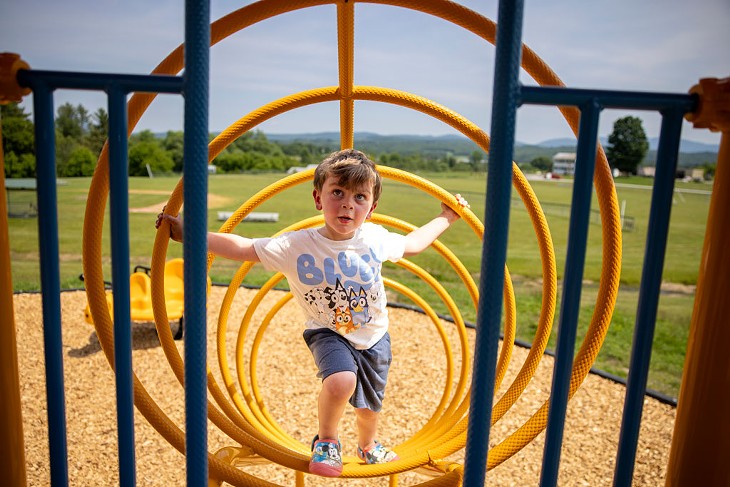
- James Buck
- Enosburgh Community Playground
Richard Amore, Better Places’ manager of placemaking and community partnerships, calls the community foundation “a core partner” in his work. In 2020, the pandemic amplified the need for public spaces, and by fall of that year, the Community Foundation had helped Better Places pull together $133,000 from statewide partners to start backing the program.
“The Vermont Community Foundation was the first one in and the first to believe in our program,” Amore said. But money wasn’t the foundation’s only contribution: “Beyond just providing the funding, they elevated the visibility of our projects to donors with giving accounts,” Amore said. “We love having them as a partner because of that visibility and their ability to move money quickly to the people that need it. We rely on them.”
Give Where Your Heart Lives
Join the VCF in building a stronger, more resilient Vermont community.
Not sure where to start?
Dan Smith, Vermont Community Foundation CEO and president, said Better Places is exactly the kind of project his organization exists to fund. “The Better Places program was a clear opportunity for us to leverage local engagement, public policy, crowdfunding application and the work of private philanthropy to accelerate things that communities wanted to do for themselves,” he said.
Strengthening Vermont’s ‘civic architecture’
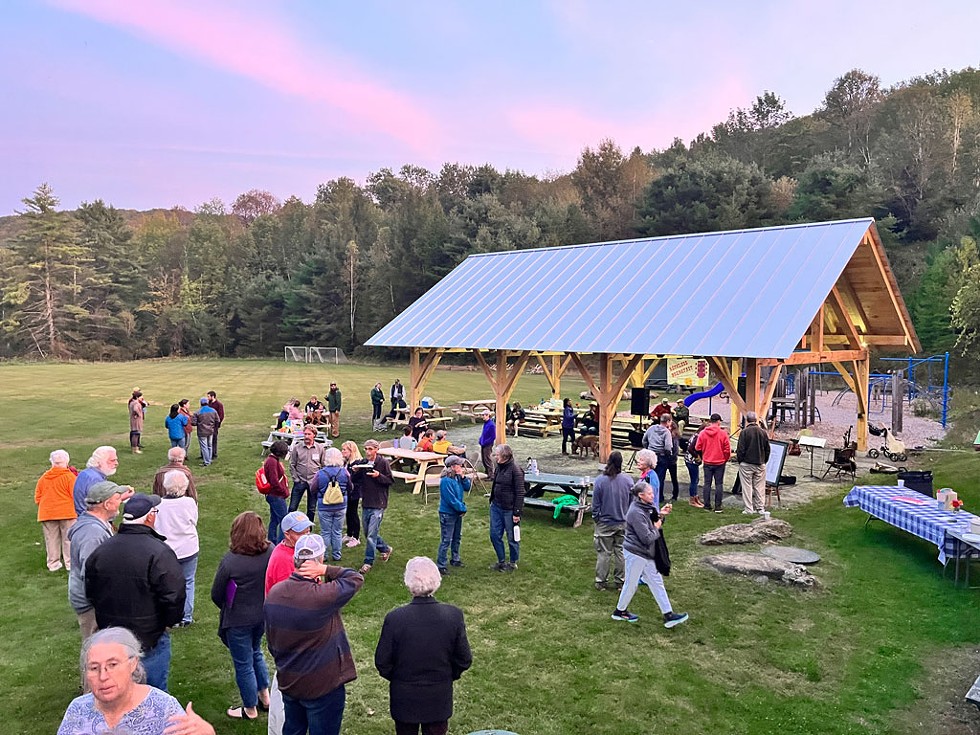
- Courtesy
- Vershire Town Pavilion
Community foundations are philanthropic entities that exist to improve the quality of life in a specific geographic area. Founded in 1986, the Vermont Community Foundation specializes in issues local to the Green Mountain State. Its team of researchers, philanthropic advisers and impact specialists studies what the state’s communities need and want, and it's ready to spring into action quickly when necessary.
That’s proven vital during natural disasters. For example, in July 2023, two months’ worth of rain fell in just two days, devastating many towns. The Vermont Community Foundation galvanized its resources to set up a relief fund that attracted contributions from 9,000 donors from all 50 states and 12 countries. It raised nearly $14 million for recovery efforts across the state. When a similar storm system struck on the flood’s one-year anniversary in July, the Community Foundation leveraged the fund to once again accept donations for recovery efforts.
The Vermont Community Foundation also focuses on long-term goals. Its newly established Democracy, Trust, and Community Leadership initiative aims to strengthen what Smith calls the state’s “civic architecture.”
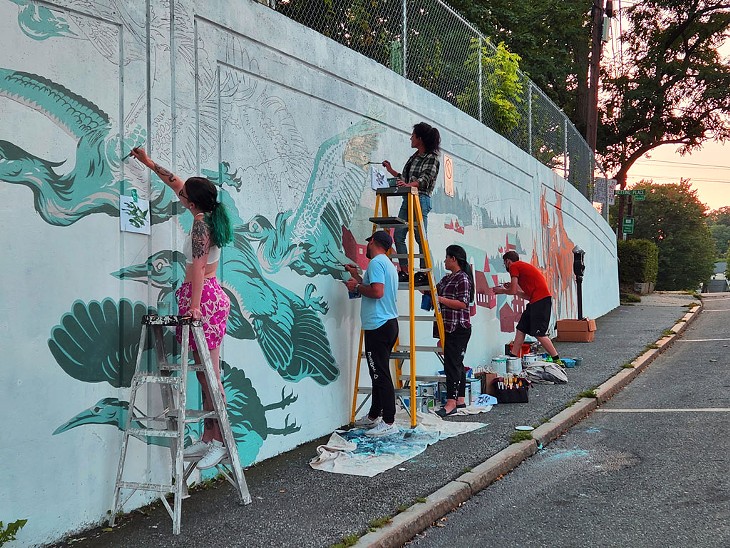
- Courtesy of Epsilon Spires
- Artists Caroline Stjarnborg (far left) and Calvin Laituri (to her right) directing volunteers at the High Street Mural in Brattleboro
Interested funders can choose to support three pillars. First: bolstering community and social cohesion through programs such as Better Places, in which residents determine and work toward their own priorities.
Second: strengthening local journalism. On June 27, the Community Foundation announced its new partnership with Press Forward, a national effort to invest more than $500 million in sustaining and reimagining local news.
In a news release announcing the new Press Forward Vermont chapter, the Community Foundation noted that employment at Vermont newspapers declined by 75 percent from 2000 to 2023, according to a new study from the University of Vermont’s Center for Community News.
Holly Morehouse, the Community Foundation’s vice president for grants and community impact, said the new Press Forward chapter will strengthen local democracy.
“We know that a robust media is critical to the democratic process and that the contraction in newsroom employees in Vermont and across the nation often creates an information void, especially in smaller communities,” she said. “More than ever, people need informed reporting about government, the economy, culture, education and other matters to engage as community members, voters, and get inspired to participate in civic life.”
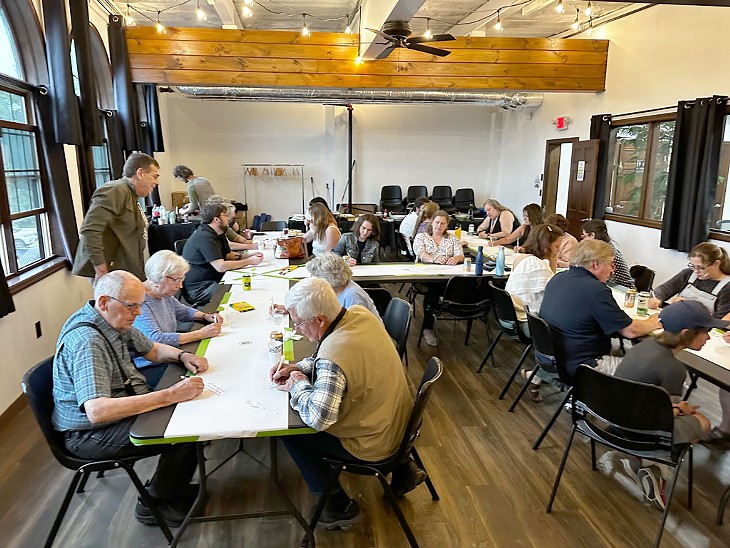
- Courtesy of Space on Main
- A Democracy Dinner at Space on Main
“Civic innovation” is the initiative’s third pillar. It’s still in the development stage and could include a broad range of programs, from plans for flood resilience to strategic ways to build more affordable housing. “We are looking at the steps we can take to make sure people have confidence in their civic institutions,” Smith said.
Peter Kinder, a nonprofit board member and expert on social investing, said he manages his Claudia and Peter Kinder Charitable Fund through the Vermont Community Foundation because he appreciates the organization’s focus on nurturing what democracy requires. “That means, for example, fostering ventures that address needs — like childcare and local recreation — that cross social and political lines. It also means supporting trustworthy sources of information on what’s happening locally,” he said. “Finally, and most importantly to me, it means keeping our kids here and attracting more young people with housing, jobs and community.”
Getting people jazzed up about where they live
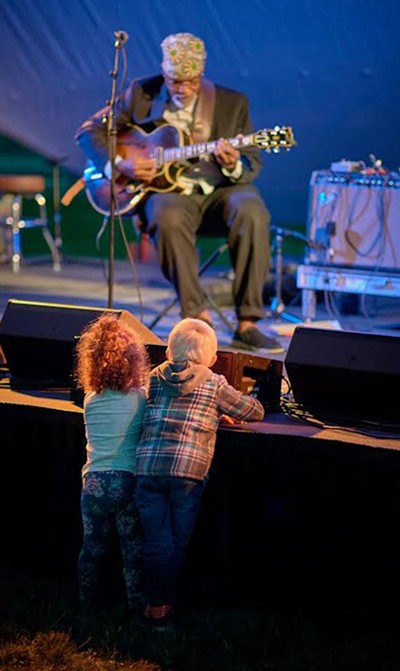
- Courtesy of Kevin Fitzgerald
- Ed Cherry at the Stowe Jazz Festival
Building community isn’t just about creating physical spaces or supporting democratic ideals — sometimes it’s about putting on a show. Stowe Jazz Festival director George Petit is about to stage 30 of them.
Stowe’s three-day extravaganza on the first weekend of August features local jazz musicians, as well as performers from Peru, Colombia, Brazil and dozens of other countries. This year’s lineup includes Grammy Award-nominated Cuban keyboardist Manuel Valera and 2024 Grammy winner for Best Jazz Vocal Album Nicole Zuraitis. During the festival, which begins on Friday, August 2, the main stage at the Alchemist in Stowe is a nonstop party with music from around lunchtime to after sunset. Doc Ponds and Piecasso Family Pizzeria are among the 10 participating venues. All told, between 3,000 and 4,000 people are expected to attend over the course of the festival weekend.
Best of all, according to Petit: “It’s 100 percent free. With most festivals, it’s costly, it’s hard to bring your kids, but we’ve got world-class Grammy-winning musicians that anyone can see with no barrier to entry,” he said. “We expose families and children to art they would never see, and that helps glue a community together.”
Though the Stowe Jazz Festival is entirely free to attend, it’s expensive to organize: about $200,000 and 10 months of work, according to Petit, who is also a jazz guitarist, composer and recording engineer. Since it began in 2016, the festival has relied mainly on community support. Petit has tried all kinds of creative ways to raise money. He’s held crowdfunding campaigns, sought sponsorship support from local businesses and received grant funding from the Vermont Arts Council.
Still, last year, he almost fell short. “I was terrified,” Petit said. He began preparing to take out a personal loan to pay for the festival when a grant proposal was approved at the last minute.
Give Where Your Heart Lives
Join the VCF in building a stronger, more resilient Vermont community.
Not sure where to start?
This year, he secured help early on from the Vermont Community Foundation. Petit received $10,000 to support the festival. “With their values of trying to help build community, this alignment just makes sense,” Petit said. “Our festival is completely supported by people who believe in what we’re doing, and the Vermont Community Foundation is numero uno.”
